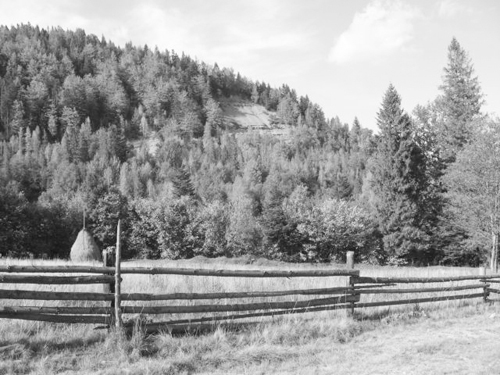
Roots
By
Orysia Sopinka Chwaluk
It was not enough for me to walk along the
paths of my ancestors. I wanted to find
the Wakeriak homestead that belonged to my mother’s family and I wanted to
create a family tree for future generations.
That meant that I had to go back to Lemkivshchyna now part of 
My first trip there, in 2007
had introduced me to the beautiful, rolling hills of the
An uncle had shown me a
picture of a house that the villagers called do Danila. There was a cement well and three old ash
trees standing in front of it. This was my grandmother’s home before she
married and the whole family lived there temporarily after their house burned
down. He said that my Grandfather Wakeriak’s homestead was directly across the
river from Danilo’s and that his land extended to the town of
The day I went to Czystohorb,
I had a premonition that I would find Danilo’s house. As I walked along the
dirt road in Vyshchyj Kinets, I noticed a particular house with a new well and
three ash trees. After spending some
time looking at it from different angles, I realized that I had found what I
was looking for. I quickly ran down to
the river and blessed myself with the cool water, all the while thinking about
my mother as a young girl coming here for water. Then, I walked along the dirt road to see how
the village had changed in three years.
A lot of buildings had been renovated and some new cottages were just
about completed. I walked back towards
the house and crossed the river in front of it. I knew I was standing on the
land where my Grandfather Wakeriak had built his house and all the land behind
it right up to the top of the hill where Jawirnyk started had belonged to his
family for centuries. As if God wanted
everyone to know that this land was special, a Lemko cross, surrounded by
flowers stood near the property. Back in
the 1950s, a forestry company used the Wakeriak’s house as an office until a
new road was built across the property. The house no longer stood.
Three days later, I walked
from Czystohorb to Wachaliwka, the part of Jawirnyk the Wakeriaks came from.
Using a map to guide me in the right direction, I crossed a river, then a small
forest that led me to wide fields of golden grass, a slight hill and then very
level land-Wachalivka. I could picture
my mother riding on a horse, bringing the men in the family something to eat
for lunch. When standing on top of the
hill, I basked in the beauty of the
The microfiche from the
Family History Center that I was working on held records of marriages, births
and deaths dating back to 1784 in Czystohorb, Jawirnyk and Komancha. I
continued my search for old records in the civic center of Komancha, six
kilometres from Czystohorb. Fortunately,
I found an interpreter who spoke fluent Ukrainian and Polish. There, a Polish
civil servant read who my ancestors were, while I frantically wrote down the
information, my interpreter helping me when necessary. He also gave me a map of Jawirnyk showing me
where the Wakeriak homestead was before Akcija Wisla.
The Greek Catholic church in
Komancha also had records of my family. The parish priest was very hospitable
and allowed me to read two old registers, one on prenuptial promises from
Wyslok Welykij and the other, a census in Czystohorb. It was very exciting to find the names of
everyone who lived in my grandfather’s house.
Looking through the registers made me feel as if I had attended three
big family parties - births, marriages and funerals. The archives in both Sanok and Peremyshl also
had relevant information about my family, but time did not permit me to
continue researching and the archives were closed in Peremyshl in July.
For the genealogy researcher,
there’s a wealth of information in the cemeteries adjacent to Lemko churches,
with tombstones dating back several centuries. Lemkos take pride in looking
after the graves of their dead. A group
of Torontonians, spearheaded by Ivan Olenych, raised funds for the building of
a monument to all the dead in the cemetery in Radoshytsi. Today, the church is
a kostiol, but the Poles have not yet changed its beautiful
architecture. I found graves of my
father’s relatives that I had not seen before in Komancha, Wyslok Welykij and
in a small cemetery hidden in the woods in the vicinity of Wyslok Welykij.
Pictures on tombstones made names more real.
Unfortunately, the church in Czystohorb was destroyed by fire and the
cemetery was raised to the ground by a private landowner.
Searching for roots has not
only spurred me on to learn more about the history of the place from where my
parents and ancestors came, but has also made me aware of the current problems
that the Lemko culture and people must face in order to survive. Some churches have completely fallen apart
while others are in grave disrepair. Many were burned or disassembled by the
Polish. Greek Catholic churches are becoming kostiols because of a lack
of parishioners or they become Orthodox churches. The Orthodox churches in Lemkivshchyna were
brought there to create a divide amongst the Ukrainian Catholics.
The Union of Ukrainians in
In
Those who have Lemko roots
should make a point of visiting it. There is very little land left to buy in Lemkivshchyna. There’s an amazing building boom going on in
PHOTO
Rolling hills of Lower
Beskids, Lemkivshchyna in present-day Poland